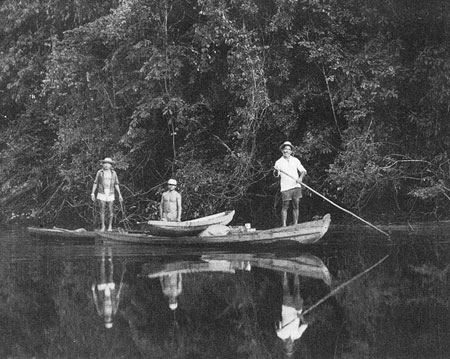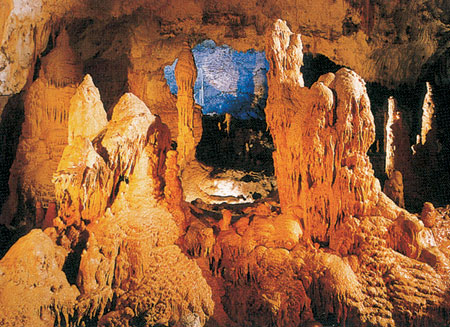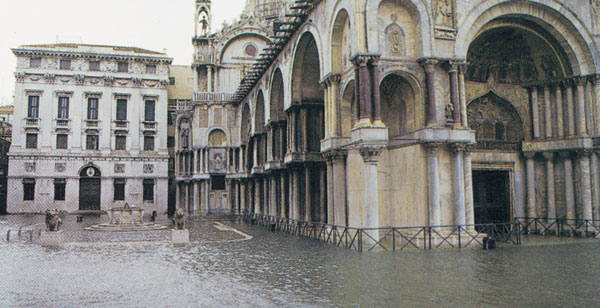Land of Ghosts, Being a Photographer, Encyclopedia of Caves and more...
By David Schneider, Roger Harris, Nancy Lutz
Short takes on six books
Short takes on six books

DOI: 10.1511/2005.54.0
Land of Ghosts: The Braided Lives of People and the Forest in Far Western Amazonia. David G. Campbell. Houghton Mifflin, $25.
Like the sinuous Amazon River he writes of so eloquently, ecologist David Campbell glides between travelogue and natural history in Land of Ghosts. In the prologue he broods, "How do I describe the inchoate green tapestry of the Amazon Valley, this apex of earthly diversity?" He comes up with a winning strategy: He describes a journey from Cruzeiro do Sul, a remote frontier town on the Juruá River in western Brazil, to his study site deep within the forest, where he has followed hundreds of individual trees from their existence as seedlings to their deaths. Interwoven with his account of that journey are threads of the larger Amazon story—the river's scientific and historical setting, engaging anecdotes recounted by his unlikely companions (Tarzan, a peripatetic Syrian raised in a brothel; Arito, a one-time caiman hunter, now a paleontologist; and Pimentel, an ace canoe driver), and descriptions of Campbell's encounters with tropical flora and fauna.

From Land of Ghosts
The tales are "edutainment," full of enticing tidbits of information about various aspects of the ecology and evolution of the rain forest. For example, in chapter 6, "On The Line," Campbell describes the refugia hypothesis, which proposed that the ice ages, by locking up great quantities of water, dried out parts of the rain forest, resulting in isolated wet patches in which species became reproductively isolated, so that speciation rates accelerated, resulting in the biodiversity hotspots seen today. Then, without missing an oar stroke, Campbell describes an attack by "arapúa bees that clamber over our faces and crawl into our nostrils, mouths, and ears." But he takes comfort in reflecting that, because he has "become the dinner of every bee, chigger, mosquito, tick and biting fly," his nutrients are "buzzing everywhere in this forest and will soon be passed on in humble, hopeful eggs."—Roger Harris
Being a Photographer. Yann Arthus-Bertrand. Abrams, $45.
The name Yann Arthus-Bertrand you might not know, but his photographs you certainly do. His evocative, sometimes haunting images are presented in Being a Photographer in approximately the order in which they were taken, so that the collection highlights his evolution as a photographer. From wildlife photography he went on to document indigenous people; the photograph to the right of a tribesman from Papua New Guinea was taken for a Paris fashion magazine. Next he progressed to bigger projects, such as "Good Breeding," a study of domestic livestock and their breeders; "Horses," a pictorial essay; and "Earth From Above," a compilation of spectacular aerial portraits that illustrate the beauty and fragility of our planet.

From Being a Photographer
There are plenty of stunning pictures, but the book also offers much more: The accompanying text by Sophie Troubac (translated from the French by Simon Moore) explains how Arthus-Bertrand planned and executed specific programs to acquire the images. In addition, copies of marked maps, checklists and log books, as well as an accompanying CD, provide insight into the teamwork and dogged persistence needed to get the awe-inspiring photographs. Arthus-Bertrand emphasizes the importance of captions; in "Earth From Above" each caption explains the picture and describes the ecological or social problems (whether local or worldwide) that the image illustrates. Sequences of slides from the same roll enable the reader to see how the best images were chosen and how, as time passed, the opportunities for exceptional images arose and then faded away. But the lessons learned from this book will never fade.—Roger Harris
Encyclopedia of Caves. Edited by David C. Culver and William B. White. Elsevier/Academic Press, $99.95.
Prior to actually holding a copy of Encyclopedia of Caves in my hands, I would have been skeptical that it was something I'd want occupying my precious bookshelf space. I'm fascinated by caves, mind you, but an encyclopedia? On seeing the cover, however, I was convinced without even cracking the book open: Coeditor and Penn State professor emeritus William B. White is one of the greats of cave geochemistry. I was not disappointed.

From Encyclopedia of Caves
Assembled alphabetically, the 107 entries range from descriptions of exceptional cave systems, to cave-formation processes, to the systematics of cave biota, to evolutionary diversions of cave life—and well beyond. Although scientifically rigorous, the articles are readily approachable by the nonprofessional and at times include the reader in the "hows" of cave exploration. Truly international in both geography and contributors, this encyclopedia is one for browsing—the perfect assemblage of 15- to 20-minute intellectual diversions. I must confess, though, that my favorite entries were those written by White himself.—David Schoonmaker
Digital Retro: The Evolution and Design of the Personal Computer. Gordon Laing. Sybex, $29.99.
Some people use the various cars they've owned over the years to delineate different phases of their lives. Others—many scientists included—do the same with their computers. Thus flipping through the pages of Gordon Laing's Digital Retro, with its lavish photos and amusing descriptions of computer models from the 1970s, '80s and '90s, will likely send you on a sentimental journal back in time.

From Digital Retro
Did you own, or maybe just use, an Apple II (above) soon after it hit the market in 1977? If so, the sight of that beige box will probably conjure up memories of the time when Star Wars was a fresh concept and the Force was still with you. If not, perhaps Laing's description of the Radio Shack TRS-80 (the "Trash-80" to microcomputer aficionados) or the Commodore PET 2001 will get the nostalgia flowing.
Those who are a little younger than this reviewer might have to browse on further to enter the realm of personal experience—say, with Laing's description of the first IBM PC or the Apple Macintosh, which came out, respectively, in 1981 and 1984. But what makes Digital Retro so much fun is its coverage of less successful models, such as the boxy MITS Altair 8800 or the luggable-if-not-exactly-portable Osborne 1. I was of course disappointed not to see featured the first microcomputer I owned (one with a genuine wood case, made by a company called Polymorphic Systems), but I found plenty in Laing's book to keep me wistful for that long-gone time when personal computers did a whole lot less yet were loved a lot more.—David Schneider
Nature's Strongholds:The World's Great Wildlife Reserves. Laura and William Riley. Princeton University Press, $49.50.
In this era of embattled ecosystems, governments are setting aside natural areas to protect them. These have been systematically cataloged for the first time, by Laura and William Riley, in Nature's Strongholds, which offers conservationists, wildlife enthusiasts, travel professionals, ecotourists and armchair travelers detailed information about the world's best reserves and parks. The entries for each "stronghold" are organized by country, within chapters corresponding to the continents. Each entry includes such information as the size of the protected area, opportunities to view the wildlife and the best time to visit. All the world's major national parks are included, as are most of the important reserves of lesser status. The book is not designed to be read from cover to cover, but rather to serve as a reference.

From Nature's Strongholds
In a few respects, the volume does leave something to be desired. Each country map indicates the location of national parks with a square icon, whereas an outline of the protected area would have been more informative. Reserves discussed in the text are not depicted on the book's maps at all. The photographs spectacularly illustrate the wildlife (a roseate spoonbill from South America is shown above right) but give little impression of place. These criticisms aside, no other book compares with this one in scope. It serves as a reminder of what humanity stands to lose in the battle to preserve the world's last natural "strongholds."—Roger Harris
The Pecking Order: Which Siblings Succeed and Why. Dalton Conley. Cloth: Pantheon, $24; Paper (with a different subtitle): Vintage, $14.
Inequality starts at home, says sociologist Dalton Conley. In The Pecking Order, Conley demonstrates that, much as we might like to think of the family as "a haven in a harsh world," it's actually "part and parcel of the world, rat race and all." Status hierarchies in families, which involve "battling wills" and relationships that repeatedly realign themselves or break down, affect us in ways that end up helping determine "our place in the larger pecking order we call society."
What are some of the things that differentially affect siblings and help determine their success or lack thereof? Conley discusses the influence of family background, genes, the environment, birth order, family size, death, desertion, divorce, remarriage, geographic mobility, immigration, technological changes, gender dynamics, physical appearance, maternal role models, family income, health problems, imprisonment, war and personal tragedy. One of Conley's more interesting points is that middle children, who never have their parents' attention all to themselves, always live in a child-dominated world, sometimes in the care of older siblings, sometimes caring for younger ones.
The first chapter illustrates the inequality that manifests itself within families by contrasting two siblings, Bill and Roger, one of whom grows up to be the 42nd president of the United States, whereas the other becomes a ne'er-do-well. Anecdotes and examples are abundant throughout the text, which is geared toward grabbing the attention of a general audience. Conley devotes 25 percent of the book to extensive scholarly notes that refer readers to the research on which his claims are based. Most of the counterarguments to his position are confined to the notes; in the text itself, readers are presented only with information that supports the argument that family dynamics mold the child's success.
Will this book dispel all the folklore surrounding the effects of birth order and chances of success? No, but it is both fascinating and thought-provoking.—Nancy C. Lutz
The Science of Saving Venice. Caroline Fletcher and Jane da Mosto. Paul Holbertson Publishing. Paper, $15.
Venice draws 16 million visitors a year, but few of them realize that the city is in peril. It's slowly sinking, and sea levels are rising: St. Mark's Square (right) is now flooding six times more frequently than a century ago. The Science of Saving Venice, by Caroline Fletcher and Jane da Mosto, is the clear-eyed product of a three-year research project based at the University of Cambridge and a 2003 conference held there to explore solutions to the city's plight.

From The Science of Saving Venice
Finding a solution, Fletcher and da Mosto write, will require both engineers and ecologists. Venice lies in a coastal lagoon, the largest wetland in Italy, but 1,000 years of human intervention have degraded it profoundly, and storm surges from the Adriatic now threaten more extreme flooding.
Most scientists support building barriers at the lagoon's inlets, a promising measure first considered in the 17th century. But time is pressing: The city's population has already dropped by more than half since the 1950s. Worse, global warming could raise the local sea level by 70 centimeters by the end of this century, a perilous outcome in a city whose highest land is only two meters above sea level. For now, the authors write, "The city is under siege."—Greg Ross
Click "American Scientist" to access home page
American Scientist Comments and Discussion
To discuss our articles or comment on them, please share them and tag American Scientist on social media platforms. Here are links to our profiles on Twitter, Facebook, and LinkedIn.
If we re-share your post, we will moderate comments/discussion following our comments policy.